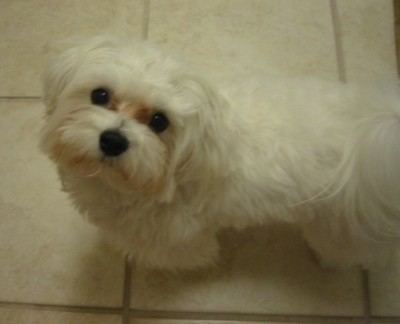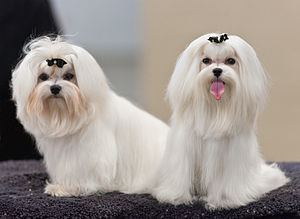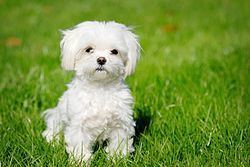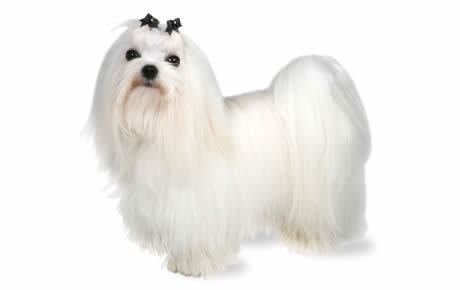Common nicknames Maltese lion dog Weight Male Litter size avg. 1 to 3 puppies. Life span 12 – 15 years Origin Mediterranean Basin | Patronage Italy Coat white Hypoallergenic Yes Color White | |
 | ||
Other names Canis familiaris Maelitacus Temperament Lively, Playful, Easygoing, Gentle, Docile Height Male: 21–25 cm, Female: 20–23 cm Similar Shih Tzu, Pomeranian, Yorkshire Terrier, Poodle, Havanese | ||
The Maltese [malˈteːze], Canis familiaris Maelitacus, is a small breed of dog in the Toy Group. It descends from dogs originating in the Central Mediterranean Area. The breed name and origins are generally understood to derive from the Mediterranean island nation of Malta.
Contents

History

This ancient breed has been known by a variety of names throughout the centuries. Originally called the "Canis Melitaeus" in Latin, it has also been known in English as the "ancient dog of Malta," the "Roman Ladies' Dog," the "Maltese Lion Dog," and "Melita" (the former name of Malta). The origin of the common name "Cokie" is unknown, but is believed to have originated in the mid-1960s on the U.S. East Coast and spread in popular use. This breed has been referred to falsely as the "Bichon", a name that refers to the family ("small long-haired dog") and not the breed. The Kennel Club officially settled on the name "Maltese" for the breed in the 19th century.

The Maltese is thought to have been descended from a Spitz-type dog found among the Swiss Lake Dwellers and was selectively bred to attain its small size. There is also some evidence that the breed originated in Asia and is related to the Tibetan Terrier; however, the exact origin is unknown. The dogs probably made their way to Europe through the Middle East with the migration of nomadic tribes. Some writers believe these proto-Maltese were used for rodent control before the appearance of the breed gained paramount importance.

The oldest record of this breed was found on a Greek amphora found in the Etruscan town of Vulci, in which a Maltese-like dog is portrayed along with the word Μελιταιε (Melitaie). Archaeologists date this ancient Athenian product to the decades around 500 BC. References to the dog can also be found in Ancient Greek and Roman literature.
Aristotle was the first to mention its name Melitaei Catelli, when he compares the dog to a mustelid, around 370 BC. The first written document (supported by Stephanus of Byzantium) describing the small Canis Melitaeus was given by the Greek writer Callimachus, around 350 BC. Pliny suggests the dog as having taken its name from the Adriatic island Méléda; however, Strabo, in the early first century AD, identifies the breed as originating from the Mediterranean island of Malta, and writes that they were favored by noble women.
During the first century, the Roman poet Martial wrote descriptive verses to a small white dog named Issa owned by his friend Publius. It is commonly thought that Issa was a Maltese dog, and various sources link Martial's friend Publius with the Roman Governor Publius of Malta, though others do not identify him.
John Caius, physician to Queen Elizabeth I, also claimed that Callimachus was referring to the island of Melita "in the Sicilian strait" (Malta). This claim is often repeated, especially by English writers. The dog's links to Malta are mentioned in the writings of Abbé Jean Quintin d'Autun, Secretary to the Grand Master of the Knights of Malta Philippe Villiers de L'Isle-Adam, in his work Insulae Melitae Descriptio.
Around the 17th and 18th centuries, some breeders decided to "improve" the breed, by making it smaller still. Linnaeus wrote in 1792 that these dogs were about the size of a squirrel. The breed nearly disappeared and was crossbred with other small dogs such as Poodles and miniature Spaniels. In the early 19th century, there were as many as nine different breeds of Maltese dog.
Parti-colour and solid colour dogs were accepted in the show ring from 1902 until 1913 in England, and as late as 1950 in Victoria, Australia. However, white Maltese were required to be pure white. Coloured Maltese could be obtained from the south of France.
Description
The Maltese had been recognized as a FCI breed under the patronage of Italy in 1954, at the annual meeting in Interlaken, Switzerland. The current FCI standard is dated November 27, 1989, and the latest translation from Italian to English is dated April 6, 1998. The American Kennel Club recognized the breed in 1888, its latest standard being from March 10, 1964.
Appearance
Characteristics include slightly rounded skulls, with a finger-wide dome, a black button nose and brown eyes. The body is compact with the length equaling the height and the tail is almost always curled. The drop ears with (sometimes) long hair, and surrounded by darker skin pigmentation (called a "halo"), gives Maltese their expressive look. Lacking exposure to sunlight, their noses can fade and become pink or light brown in color. This is often referred to as a "winter nose" and many times will become black again with increased exposure to the sun. The Maltese's paws are very sensitive to touch.
Coat and color
The coat is long and silky and lacks an undercoat. Some Maltese can have curly hair (especially behind their ears), but this is considered a fault. The colour of the coat is pure white. A pale ivory tinge is permitted on the ears. In some standards, a pure white coat with slight lemon markings is tolerated.
The Maltese does not shed, and is therefore a good choice for people with dog allergies. Some people prefer their dogs to have the coat short. The most common cut for the Maltese is called "the puppy cut," which involves trimming or shaving the entire body (skirt, legs/paws, chest, and head fur) to one short length (typically less than an inch long).
Size
Adult Maltese range from roughly 3 to 10 lb (1.4 to 4.5 kg), though breed standards, as a whole, call for weights between 5-8 lbs. There are variations depending on which standard is being used. The American Kennel Club calls for a weight between 4 to 7 lb (1.8 to 3.2 kg), with 4 to 6 lb (1.8 to 2.7 kg) preferred, while the FCI standard popular in Europe prefers a heavier Maltese between 3 to 4 kg (6.6 to 8.8 lb). They stand normally 7 to 12 in (18 to 30 cm).
Gait
As per the AKC standard: The Maltese moves with a jaunty, smooth, flowing gait. Viewed from the side, they give an impression of rapid movement, size considered. In the stride, the forelegs reach straight and free from the shoulders, with elbows close. Hind legs to move in a straight line. Cowhocks or any suggestion of hind leg toeing in or out are faults.
Temperament
Maltese are bred to be cuddly companion dogs. They are extremely lively and playful, and even as a Maltese ages, their energy level and playful demeanor remain fairly constant. Some Maltese may occasionally be snappish with smaller children and should be supervised when playing, although socializing them at a young age will reduce this habit. They also adore humans, and prefer to stay near them. The Maltese is very active within a house, and, preferring enclosed spaces, does very well with small yards. For this reason, the breed also fares well in apartments and townhouses, and is a prized pet of urban dwellers. Some Maltese may suffer from separation anxiety.
An Australia-wide (not including Tasmania) research project carried out in conjunction with RSPCA found owners likely to dump their Maltese. citing the tendency of Maltese to bark constantly. This breed is Australia's most dumped dog. In addition, figures released in 2010 by the Korean National Veterinary Research and Quarantine Service show that some 1,208 Maltese were abandoned between January and August 2010, making it the most abandoned breed in Seoul, South Korea.
Care
Maltese have no undercoat, and have little to no shedding if cared for properly. Like their relatives, the Poodles and Bichon Frisé, they are considered to be largely hypoallergenic and many people who are allergic to dogs may not be allergic to the Maltese. Daily cleaning is required to prevent the risk of tear-staining. Many owners find that a weekly bath is sufficient for keeping the coat clean, although it is recommended to not wash a dog so often, so washing every three weeks is sufficient, although if the dog keeps clean even longer than that. They need to be professionally groomed about once every month and a half.
Regular grooming is also required to prevent the coats of non-shedding dogs from matting. Many owners will keep their Maltese clipped in a "puppy cut", a 1–2 in (2.5–5 cm) all over trim that makes the dog resemble a puppy. Some owners, especially those who show Maltese in the sport of conformation, prefer to wrap the long fur to keep it from matting and breaking off, and then to show the dog with the hair unwrapped combed out to its full length. Some Maltese need to be blow-dried in order to prevent mats because drying is ineffective to some dogs.
Maltese dogs can exhibit signs of tear staining underneath the eyes. Dark staining in the hair around the eyes ("tear staining") can be a problem in this breed, and is mostly a function of how much the individual dog's eyes water and the size of the tear ducts. To get rid of tear staining, a solution or powder can be specially made for tear stains, which can often be found in local pet stores. A fine-toothed metal pet comb, moistened with hot water and applied perhaps twice weekly, also works extremely well. The antibiotic Cephalexin has been shown to completely clear up "tear staining" in some cases. Maltese are susceptible to "reverse sneezing", which sounds like a honking, snorting or gagging sound and results often from over-excitement, play, allergies, or upon waking up. It is not life-threatening or dangerous—it will go away after about a minute.
They are ranked 59th out of 79 in Stanley Coren's The Intelligence of Dogs which indexes obedience and the ability of a dog breed to follow commands, with very light focus on skills seen outside of working breeds, such as emotional intelligence.
Maltese tend to have many or several tooth problems usually resulting in cavities, without proper care the infected teeth may fall out as the dog gets older. Maltese might need additional care and have their teeth brushed with soft-bristled toothbrush and special dog toothpaste every week to avoid tooth problems.
